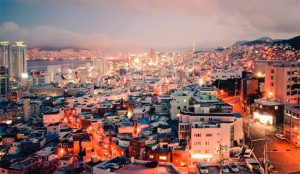Demographically it’s the increase in population of cities and towns ,while sociologically it’s the spread of urban way of life to the country side .
Urbanization in India has occurred more slowly than in other developing countries and the proportion of the population in urban areas has been only 28 per cent based on the 2001 census. The pace of urbanization is now set to accelerate as the country sets to a more rapid growth. Economic reform has already unleashed investment and growth offering its citizens rich opportunities. Surging growth and employment in cities will prove a powerful magnet. 300 million Indians currently live in towns and cities. Within 20-25 years, another 300 million people will get added to Indian towns and cities. This urban expansion will happen at a speed quite unlike anything that India has seen before. It took nearly forty years for India’s urban population to rise by 230 million. It could take only half the time to add the next 250 million. If not well managed, this inevitable increase in India’s urban population will place enormous stress on the system.
In Census of India, 2001 two types of town were identified (R.G,2001):
a) Statutory towns : All places with a municipality, corporation, Cantonment board or notified town area committee, etc. so declared by state law.
b) Census towns : Places which satisfy following criteria :-
i) a minimum population of 5000 ;
ii) atleast 75% of male working population engaged in non agricultural pursuits; and
iii) a density of population of atleast 400 persons per sq km
Dimensions of urbanization :-
- detrographic – growth of urban population and metropolitan cities .
> pattern of urbanization
> urban -agglomeration (>1 million)
> rapid urbanization or over – urbanization
- Social
– urbanism as a way of life
> distinct Social relationship due to large lense and permanent setlelement of socially heterogeneous individuals.
> effects of city wider than city itself – urban infuence in surrounding area
– primary ( by great tradition ( carry regional traditions) ) & secondary urbanization ( due to industrialization disintisgrate regional tradition by bringing external element to
city )– changing social and
economic institutions> increased secondary & tertiary activities
> visible change in caste system ,joint family ,neighbourshood
> induces ruler urban migration
Problems of urban areas
- Over – urbanisation – excessive population pressure on civic amenities ,housing ,etcs
- Inadequate housing – nearly 70 % live in substances housing .
- Unsafe and insufficient water supply
- Pollution
- Inefficien and inadequate transport
- Environmental decay
- Slums – poor housing
– higher density of population
– lack of public utilization – sanitation ,water
– crime , drug abuse , alcoholism , poverty ,
prostitution, beggary
– social isolation
- Crime
- Isolation -lack of social interaction
- Mala adjustment
- Power shortage
- Garbage
State policy on urban problem
- Legislation related to urban land and holding
= rent control act ,1948
=urban land ceiling and regulation act ,1976
- Programes of slum clearence & construction of new house
= national housing bank ( 7th plan )
- Finance of housing
- Town water supply and swage
- Urban transport
- Master plan for development (2030)
- GPSC Mains 2025 Tests and Notes Program
- GPSC Prelims Exam 2025- Test Series and Notes Program
- GPSC Prelims and Mains 2025 Tests Series and Notes Program
- GPSC Detailed Complete Prelims Notes

